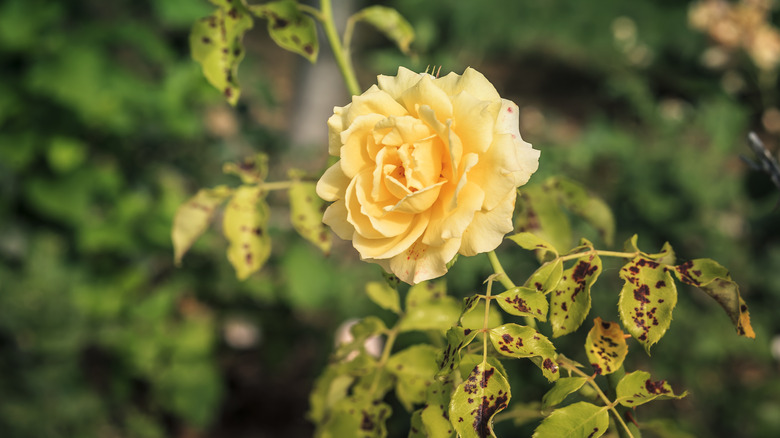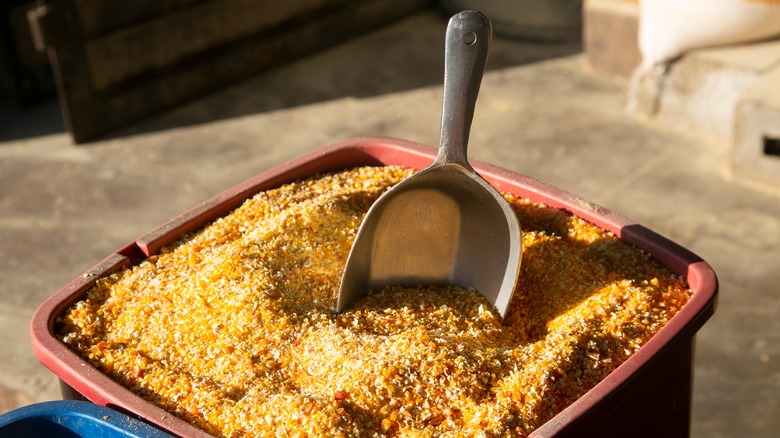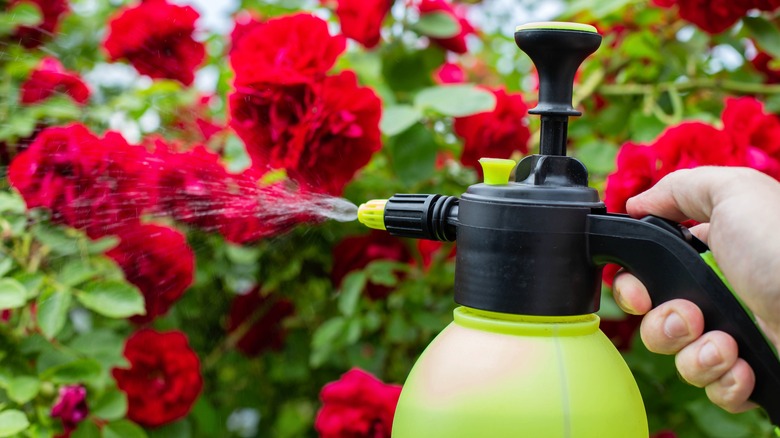This Pantry Staple May Help Protect Your Roses From Black Spot Disease
It's late spring, and you're proudly surveying the carefully nurtured rose bushes scattered throughout your garden beds. After all, they're difficult plants to grow in the garden, and it's not long now until the first blooms! You lean into the nearest plant, and as you do, you notice a blemish, then another, and another. Is it the dreaded black spot? Not to worry; there's a cost-effective remedy some experts claim is the solution to this rose-ruining problem. Typically, you'd use it to make grandma's Thanksgiving cornbread. You guessed it! Cornmeal — similar to the stuff you probably have right now in your pantry.
A particular species of fungus called Diplocarpon rosae is the culprit behind rose black spot. What black spot on roses looks like is, essentially, a bunch of fuzzy brown spots on the leaves or canes of a plant. Each spot measures a half-inch or smaller and sometimes has a yellow center. Eventually, an entire leaf is covered in spots, turns yellow, and falls off. The spots produce spores, which hitch a ride to other parts of the rose bush — or other bushes nearby — in water droplets, and the infection process repeats itself. While some non-chemical treatment options exist, like keeping plants as dry as possible and discarding fallen leaves and branches immediately, most experts advise using commercially made protectant fungicides. Gardeners tending toward an organic garden or wanting to avoid using chemicals may feel stuck when treating the disease. That's where cornmeal comes in... or does it?
It's complicated: the for and against
The argument for cornmeal as a black spot deterrent seems to stem from research done by Dr. Joe McFarland at the Texas A&M Research Station sometime before his retirement in the mid-2010s. McFarland and his team used cornmeal to treat fungal diseases in peanuts. It doesn't kill the diseases; instead, it encourages the growth of cannibalistic fungi in the Trichoderma genera, groups of organisms that just so happen to feed on the fungi gardeners consider harmful. The cornmeal needs to be activated — simply watered — to work. The Texas Organic Research Center also reported positive results from a multi-season experiment (through the mid to late 2010s) using cornmeal drench and broadcast to treat fungal infection in oak trees.
But it's not all roses in the fight against the rose's most dreaded fungal foe, at least where cornmeal is concerned. More recently, experts have pointed out that the cornmeal treatment was proven effective against a specific peanut-eating fungus, not rose black spot — or, indeed, any other fungal diseases. A peer-reviewed WSU Extension Home Garden Series pamphlet released in 2019 takes things a step further and actively advises against using cornmeal as a fungicide. While cornmeal may boost beneficial soil microbes (as they feed on the cornmeal), it also does the same for harmful fungi species. As author and professor Linda Chalker-Scott points out, there's no scientific evidence to prove that cornmeal is an effective fungicide, and it's not legally allowed to be sold or used (at least commercially) as such.
Interested in experimenting?
As you can see, the jury's out on whether cornmeal can save your roses from harmful black spot disease. Certainly, cornmeal won't harm your roses, so trying the method might be worth experimenting with. If that's you, first, you'll need to source whole-ground cornmeal, sometimes called coarse-ground or horticultural cornmeal. Walmart sells a three-pack of 5-pound bags of Kauffman Orchards coarse-ground corn meal for $39.99. Get a 2.4-pound bag of organic yellow flint cornmeal, ground coarse on an Austrian traditional stone mill, for $14.95 from Maine Grains. Grain in hand, it's time to tackle that fungus problem.
The easiest way to apply cornmeal is to "spread a handful around the base of a rose bush in spring as the buds start to appear," Gardeningetc's Amateur Gardening and trees, shrubs, and climbers expert John Negus. Repeat every month, watering the soil thoroughly after each application. Use 2, 20, or up to 50 pounds for every 100 square feet of garden or half a cup per plant. Note that this method is preventative — it won't remove spots from leaves. You can also make a foliar (leaf and steam) spray "tea" by putting one cup of cornmeal into an old sock or cheesecloth bag and soaking it in 1 to 5 gallons of water. This concoction works well as a soil drench, too. Mix compost tea, molasses, or wheat bran into the raw cornmeal or tea to create a fungus-fighting fertilizer.


